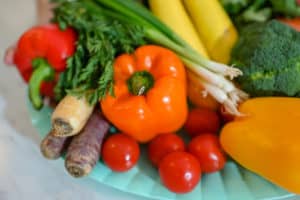
Gut Bacteria and Probiotics
Are probiotics worth the cost?
Read More or watch the Video Here: https://youtu.be/VDs1smjaLQ0
In order to understand how to take care of your gut and decide if you would benefit from probiotics, let’s first build an understanding of what gut bacteria is and how it affects your health.
Some Facts:
You can look at your gut microbiome as the “Chief of Staff” when it comes to your health.
At least 50% of the cells living in our bodies are NOT human cells. Instead these cells are made up of microbes. Which begs the question are we serving them or are they serving us?
Unless we care for these microbes well we can get sick.
There are several types of microbiomes throughout our bodies.
- Oral
- Skin
- Vaginal
- Stomach
- Colon
Stomach and Colon represent 90% and that will be our focus.
Another important microbiome to consider is soil.
Humans have become efficient microbial murders in the last 70 years.
- Antibiotics
- Antiseptic Cleaners
- Pesticides and herbicides. (Poor soil health = less nutritious food)
Diversity in the microbiomes is extremely important and affected as we age.
Low Diversity often = Disease
You may have heard of Dysbiosis – this is often defined as an “imbalance” in the gut microbial community that is associated with disease. This imbalance could be due to the gain or loss of community members or changes in relative abundance of microbes.
What do the GOOD bacteria do?
- Synthesis Vitamins
- Responsible for some gene expression
- Work with our immune system
- Digestion
- Metabolic function
- Mental health
Symptoms of unbalanced microbiome:
- Acid Reflux
- Constipation
- Gut Discomfort
- Diarrhea
- Fatigue
- There is even data that supports that poor mood, stress, depression and anxiety can even be a sign of an unbalanced microbiome. To learn more about this specifically reference “The Better Brain” by Bonnie J Kaplan.
Let’s dive into how we maintain GOOD microbiome health:
- EAT plants and other fiber rich whole foods – Plants provide a broad spectrum of minerals, vitamins, and other nutrients. They contain fibrous prebiotics, which feed the good bacteria. Some other examples of fibrous prebiotic rich foods include dried beans, legumes, whole grains, oats and flax seeds.
- Add Probiotic rich foods.
Yogurt, Kefir, Sauerkraut (unpasteurized), Kimchi, Kombucha, pickles (no vinegar), Cheese (live and active cultures)
- Drink Water – dehydration is one of the most common reasons for constipation. The majority of beneficial gut bacteria reside in the large intestines. If your stools are staying in your large intestine for an extended period of time because you are constipated, this doesn’t create a welcome environment for your healthy gut bacteria.
- Eat less sugar. Studies have shown that too much sugar in a person’s diet can negatively affect a person’s gut biome leading to imbalances. These imbalances can actually cause you to crave more sugar. Sugar is fine in small doses, especially if you’re making healthy choices at meal times.
- Moderate Alcohol consumption – Some studies suggest that chronic alcohol consumption can cause bacterial overgrowth which can throw off the overall gut microbiome balance.
- Eat less processed foods and inflammatory oils (fried foods) – Very similar to alcohol, highly processed foods can cause an overgrowth of destructive bacteria affecting the overall gut microbiome balance.
Does Taking a Probiotic help and is it worth the cost?
Unfortunately the science is not clear when it comes to gut health. There are a lot of things that are unknown when it comes to creating the right types and amounts of gut bacteria. Again what we do know is DIVERSITY is key.
What we do know is that consuming foods with probiotics, eating nutrient dense foods and supplementing with probiotics when needed can be very effective in maintaining gut microbiome diversity.
When could probiotic supplementation be useful?
After the use of antibiotics, after an illness or if you are looking to improve a specific condition.
If you choose to take probiotics. Look for a product that has been tested for whatever you are looking for. For example IBS you would want to look for probiotics that have been proven effective. It may take some time to find the probiotic that works for you. If you notice no benefits from one product after a few weeks, try a different one with a different strain of bacteria.
Also I have read that you should take your probiotic 15 min before your first meal of the day.
Other tips for buying probiotics:
- Pay attention to how the product is stored. If the product says to keep refrigerated and it is sitting on the store shelf you can make a good guess that the potency of the product has declined.
- Look at the number of CFU’s on the bottle. Colony Forming Units. This is how manufacturers quantify the number of live bacteria that make up one serving of probiotics. CFUs are the same thing as “Live Cultures”. Make sure that the product you are choosing has a CFU Guarantee through the expiration date. Some experts recommend avoiding any bottle that says CFU’s at the time of manufacture.
- The number of CFU a person needs will ultimately depend on their purpose for taking probiotics. While most studies show that 10-20 million CFU are adequate for probiotic benefits, larger CFUs may be more suitable for individuals requiring significant support and/or seeking relief from certain health conditions.
- Look for 3rd party testing. In the United States probiotics are sold as “dietary supplements” which means that companies do not have to test their products to prove that they work or that they are safe. Look for companies that are 3rd party tested. You can usually find this on the company’s website.
Safety with probiotics.
Most probiotics are safe for use.
If you have a weakened immune system, serious medical condition or have recently had surgery, probiotics may not be safe for you. This should be discussed with your MD.
Bottom Line:
Eat whole less processed foods.
Add some probiotic rich foods.
Supplement if you feel it may improve a condition.
Pay attention to signs and symptoms of poor gut health.


